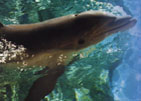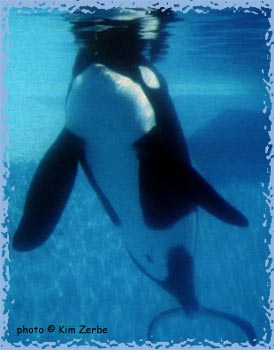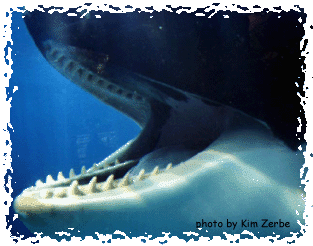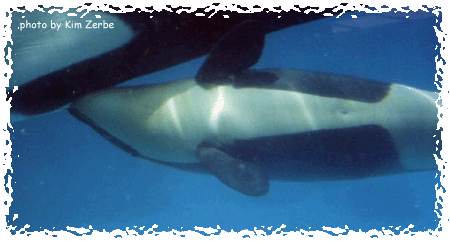 |  |  |
|
Family: |
LOCATION Orcas, also known as killer whales, can be found all over the world. They have been documented in the polar regions of Antarctica to the warmer waters of the Gulf of Mexico. Orcas are more commonly found in colder waters, however, and seem to prefer more costal regions.
Orcas are very distinctive in appearance. They have a blunt rostrum, unlike the longer "beak" found in other dolphin species. Pectoral flippers are rounded, and they have a distinct dorsal fin. Their underside is largely black with a white underside. The white stretches from the lower jaw, down between pectoral flippers and to the genital area. Two white patches sweep up from the underside along the orca's flanks. The underside of the flukes are also white. This type of coloration is known as countershading. The light underside of the orca blends in with the surface when viewed from below, and the darker back of the orca blends in with the ocean depths when viewed from above. There is also a oval shaped white patch behind each eye. The eyespot helps break up the shape of the orca and is known as disruptive coloration. It may help the orca sneak up on prey, or it could help other orcas identify the locations and positions of other members of their species. Behind the dorsal fin is yet another patch, typically grey in color. This marking is known as the saddle patch, and researchers can use the appearance of the dorsal fin along with the saddle patch to identify individual wild orcas. Saddle patches may vary in appearance on the left and right side. Orcas are sexually dimorphic, which is to say that there are differences in appearance between males and females. Males, once they reach maturity, have tall dorsal fins that can reach up to six feet (1.8 m) in height. Females, along with immature males, have a shorter curved dorsal fin up to three feet (0.9 m) in height. Males also have larger pectoral flippers and tail flukes. As they age, their flukes often curl downwards at the tips. Depending on region, basic appearance can change. For example, orcas in Antarctica are more of a light grey and yellow in color, compared to the typical black and white. Some populations in Antarctica have very small eyepatches compared to almost overly large eyepatches of orcas found in Norway. DIET & BEHAVIOR Each day an orca needs to consume anywhere from 3-4% of their body weight. They have anywhere from 40-56 conically shaped teeth. These teeth are not used for chewing, but are suited for grasping and tearing. Diet varies widely based on region. Within the northern Pacific region, two distinct populations of orcas have been studied. One type, known as transients, is known for hunting marine mammals. They will consume sea otters, seals, sea lions, and great whales. They will even grab deer that are swimming from one island to another.
Various populations around the world eat even a wider variety of food. In Antarctica, orcas will feed on penguins. In New Zealand, they seem to prefer sting rays. Behavior also varies depending on population. While all orcas are known for breaching, spyhopping, and lobtailing, certain behaviors are limited to a specific region. For example, orcas in Argentia and the Crozet Islands are known for intentionally beaching themselves in order to capture prey. The Northern Residents off the coast of Canada's west coast are known for visiting a rubbing beach. Here, the orcas will slide along the bottom, rubbing themselves against the smooth stones found there. Vocal and social behavior also varies between populations. Orcas who hunt marine mammals typically live in small, silent groups. These groups usually consist of 3-5 individuals and may be a mother with several offspring, or unrelated individuals. They are typically quiet in order to sneak up on prey, though once they make a kill they vocalize. Fish eating orcas live in larger, more vocal groups. Pods may be made up of a grandmother, her children, grand children, and perhaps even great grandchildren. Orca fathers come from different pods. This is known as matrilinial society, where offspring stay with their mothers their whole lives. These pods are often quite vocal and individual pods even have their own dialects. REPRODUCTION & LONGEVITY Female orcas become sexually mature at anywhere from ten to fourteen years of age. Typically, during this period, they will give birth to their first calf. Males become mature at a little older, and usually begin to "sprout" between twelve and fifteen years of age. "Sprouting" is when males begin to grow a taller dorsal fin and pectoral flippers. They may not stop growing until their early twenties.
Calves are typically born flukes first, though head first births are not unusual. In a fluke-first birth, the cold water hardens the flukes and makes it easier for the calf to swim. At birth, calves are around seven feet long (5.1 m) and weigh anywhere from 300-400 lbs (136-180 kg). Nursing is frequent at birth, though slows as the calves grow older. Food may begin being offered at a few months old, though the calf may nurse up to a year in age. In the wild, females typically live longer than males. The average age of females is around 40 years, though some have been observed living up to 80 and 90 years old. Males average 25 years, though they can live into their fifties. THREATS A healthy orca does not have any natural enemies. A female orca was even once observed killing a great white shark. Orcas still have several threats to their survival though. In the waters of Canada and Washington state, orcas have been found to carry high levels of PCBs. PCBs are toxins that become stored in the fat of orcas. Because orca milk is high in fat, a young orca can receive a lethal dose of PCBs just from nursing and may die as a result. PCBs can also lower resistance to common diseases. PCBs can be transferred from one animal to another. For example, if an orca eats a fish, and the fish has PCBs stored in fat tissue, then the orca will gain those PCBs from the fish. The higher an animal is on the food chain, the more PCBs they can carry. Transient orcas have the highest level of PCBs because they eat other marine mammals and marine mammals carry higher PCB levels than a fish does. Overfishing can also harm orcas, even those that eat marine mammals. Overfishing can remove a food source for other marine mammals, and if those marine mammals die, orcas can die from a lack of food as well. Logging also dimishes fish populations. If an area is cleared of trees, rivers may become smaller or dry up completely, removing fish breeding habitat. Boat traffic may not seem like a threat, but it can disrupt orca behavior. Some orcas live in major shipping lanes, and boats may force them to alter course. Overcrowding by pleasure craft can also disturb resting orcas or interfere with hunting behavior. During some seasons, orcas may not be able to get away from boats at all during daylight hours. In the United States and Canada, orcas are protected by marine mammal laws. Unfortunately, this protection does not extend worldwide. Some countries, such as Japan and Russia, still allow orca captures. Currently, a team in Russia is attempting to capture orcas for sale to parks in Japan. In Greenland, orcas are still hunted.
| |

 APPEARANCE
APPEARANCE
 Another population, known as residents, are primarily fish eaters. Orcas will eat a wide variety of fish, from salmon to herring.
Another population, known as residents, are primarily fish eaters. Orcas will eat a wide variety of fish, from salmon to herring.
 Gestation in orcas can last anywhere from fifteen to eighteen months, with seventeen being around the norm. They have the longest gestation of any cetacean, and only elephants have a longer gestation period.
Gestation in orcas can last anywhere from fifteen to eighteen months, with seventeen being around the norm. They have the longest gestation of any cetacean, and only elephants have a longer gestation period.